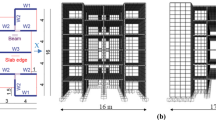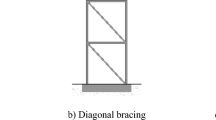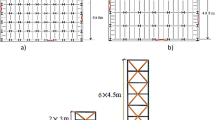Abstract
A procedure is proposed whereby input and hysteretic energy spectra developed for single-degree-of-freedom (SDOF) systems are applied to multi-degree-of-freedom (MDOF) steel moment resisting frames. The proposed procedure is verified using four frames, viz., frame with three-, five-, seven- and nine-stories, each of which is subjected to the fault-normal and fault-parallel components of three actual earthquakes. A very good estimate for the three- and five-story frames, and a reasonably acceptable estimate for the seven-, and nine-story frames, have been obtained. A method for distributing the hysteretic energy over the frame height is also proposed. This distribution scheme allows for the determination of the energy demand component of a proposed energy-based seismic design (EBSD) procedure for each story. To address the capacity component of EBSD, a story-wise optimization design procedure is developed by utilizing the energy dissipating capacity from plastic hinge formation/rotation for these moment frames. The proposed EBSD procedure is demonstrated in the design of a three-story one-bay steel moment frame.
Similar content being viewed by others
References
Akbas B, Shen J and Hao H (2001), “Energy Approach in Performance-based Seismic Design of Steel Moment Resisting Frames for Basic Safety Objective,” Structural Design of Tall Buildings, 10(3): 193–217.
Akiyama H (1985), Earthquake-resistant Limit State Design for Buildings, University of Tokyo Press, Tokyo, Japan.
ANSI/AISC 360-10 (2010), Specification for Structural Steel Buildings, American Institute of Steel Construction, Chicago, IL.
ATC 40 (1996), Seismic Evaluation and Retrofit of Concrete Buildings, Applied Technology Council, Redwood City, CA.
Benavent-Climent A (2011), “An Energy-based Method for Seismic Retrofit of Existing Frames Using Hysteretic Dampers”, Soil Dynamics and Earthquake Engineering, 31: 1385–1396.
BISPEC (2012), Earthquake Solutions, www.eqsols.com.
Chopra AK (2012), Dynamics of Structures–Theory and Applications to Earthquake Engineering, 4th ed, Pearson, Upper Saddle River, NJ.
Chopra AK and Goel RK (2002), “A Modal Pushover Analysis Procedure for Estimating Seismic Demands for Buildings,” Earthquake Engineering and Structural Dynamics, 31(3): 561–582.
Chou CC (2001), An Energy-based Seismic Evaluation Procedure for Moment-resisting Frames, Doctoral Dissertation, Department of Structural Engineering, University of California-San Diego, La Jolla, CA.
Chou CC and Uang CM (2003), “A Procedure for Evaluating Seismic Energy Demand of Framed Structures,” Earthquake Engineering and Structural Dynamics, 32(2): 229–244.
Disque RO (1971), Applied Plastic Design in Steel, Van Nostrand Reinhold, NY.
Estes KR and Anderson JC (2004), “Earthquake Resistant Design Using Hysteretic Energy Demands for Low-rise Buildings,” Proceedings of the 13th World Conference on Earthquake Engineering, Vancouver, B.C., Canada.
Fajfar P, Vidic T and Fischinger M (1989), “Seismic Design in Medium- and Long-period Structures,” Earthquake Engineering and Structural Dynamics, 18(8): 1133–1144.
FEMA 267A (1997), Interim Guidelines Advisory No. 1, Federal Emergency Management Agency, Washington, D.C.
FEMA 273 (1997), NEHRP Guidelines for the Seismic Rehabilitation of Buildings, Federal Emergency Management Agency, Washington, D.C.
FEMA 350 (2000), Recommended Seismic Design Criteria for Steel Moment-frame Buildings, Federal Emergency Management Agency, Washington, D.C.
Foti D, Bozzo LM and López Almansa F (1998), “Numerical Efficiency Assessment of Energy Dissipators for Seismic Protection of Buildings,” Earthquake Engineering & Structural Dynamics, 27: 543–556.
Gupta A and Krawinkler H (1999), Seismic Demands for Performance Evaluation of Steel Moment Resisting Frame Structures, Report No. 132, John A. Blume Earthquake Engineering Center, Stanford University, Stanford, CA.
Hernandez-Montes E, Kwon O and Aschheim MA (2004), “An Energy Based Formulation for First and Multiple Mode Nonlinear Static (Pushover) Analysis,” Journal of Earthquake Engineering, 8(1): 69–88.
Housner GW (1956), “Limit Design of Structures to Resist Earthquakes,” Proceedings of the 1st World Conference on Earthquake Engineering, California, 1–13.
IBC (2012), International Building Code, International Code Council, Country Club Hills, IL.
Kuwamura H and Galambos TV (1989), “Earthquake Load for Structural Reliability,” Journal of Structural Engineering, ASCE, 115(6): 1446–1462.
Li HN, Wang F and Lu Z H (2007), “Estimation of Hysteretic Energy of MDOF Structures Based on Equivalent SDOF Systems” Key Engineering Materials, 340: 425–440.
Liang Z, Lee GC, Dargush GF and Song J (2012), Structural Damping–Applications in Seismic Response Modification, CRC Press, Boca Raton, FL.
Manoukas G, Athannatopoulou A and Avramidis I (2011), “Static Pushover Analysis Based on Energy Equivalent SDOF System,” Earthquake Spectra, 27(1): 89–105.
Mezgebo MG and Lui EM (2016), “Hysteresis and Soil Site Dependent Input and Hysteretic Energy Spectra for Far-sourced Ground Motions,” Advances in Civil Engineering, Vol. 2016, Article ID 1548319, http://dx.doi.org/10.1155/2016/1548319
Nakashima M, Saburi K and Tsuji B (1996), “Energy Input and Dissipation Behavior of Structures with Hysteretic Dampers,” Earthquake Engineering and Structural Dynamics, 19(1): 77–90.
Perform 3-D (2011), Computers and Structures, www.csiamerica.com/products/perform-3d.
Prasanth T, Siddhartha G. and Kevin RC (2008), “Estimation of Hysteretic Energy Demand Using Concepts of Modal Pushover Analysis,” Earthquake Engineering and Structural Dynamics, 37(6): 975–990.
Ridha RA and Wright RN (1967), “Minimum Cost Design of Frames,” Journal of Structural Division, ASCE, 93(4): 165–183.
SAP 2000 (2014), Computers and Structures, http://www.csiamerica.com/products/sap2000.
Seneviratna GDPK and Krawinkler H (1997), Evaluation of Inelastic MDOF Effects for Seismic Design, Report No. 120, John A. Blume Earthquake Engineering Center, Stanford University, Stanford, CA.
Shen J and Akbas B (1999), “Seismic Energy Demand in Steel Moment Frames,” Journal of Earthquake Engineering, 3(4): 519–559.
Terapathana S (2012), An Energy Method for Earthquake Resistant Design of RC Structures, Doctoral Dissertation, University of Southern California, Los Angeles, CA.
Uang CM and Bertero VV (1990), “Evaluation of Seismic Energy in Structures”, Earthquake Engineering and Structural Dynamics, 19(1): 77–90.
UBC (1997), Uniform Building Code, International Conference of Building Officials, Whittier, CA.
Wang F and Yi T (2012), “A Methodology for Estimating Seismic Hysteretic Energy of Buildings,” ASCE 2012 International Conference on Civil Engineering and Urban Planning, Yantai, China, 17–21.
Ye L, Cheng G and Qu X (2009), “Study on Energy Based Seismic Design Method and the Application for Steel Braced Frame Structures”, Sixth International Conference on Urban Earthquake Engineering, Tokyo Institute of Technology, Tokyo, Japan, 417–428.
Author information
Authors and Affiliations
Corresponding author
Rights and permissions
About this article
Cite this article
Mezgebo, M.G., Lui, E.M. A new methodology for energy-based seismic design of steel moment frames. Earthq. Eng. Eng. Vib. 16, 131–152 (2017). https://doi.org/10.1007/s11803-017-0373-1
Received:
Accepted:
Published:
Issue Date:
DOI: https://doi.org/10.1007/s11803-017-0373-1




